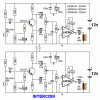joshthegeek1
New Member
Hi,
I would like to build a simple intercom using two different instances of a microphone and a speaker. I have a few LM386N-1 chips, and a 5 volt supply. Is there an easy circuit to build a mic amp with that chip, and a 10k pot as the volume control. I have an 8Ω speaker and the mic is Jameco part #136574. Thanks in advance for the help!
Josh The Geek
I would like to build a simple intercom using two different instances of a microphone and a speaker. I have a few LM386N-1 chips, and a 5 volt supply. Is there an easy circuit to build a mic amp with that chip, and a 10k pot as the volume control. I have an 8Ω speaker and the mic is Jameco part #136574. Thanks in advance for the help!
Josh The Geek



